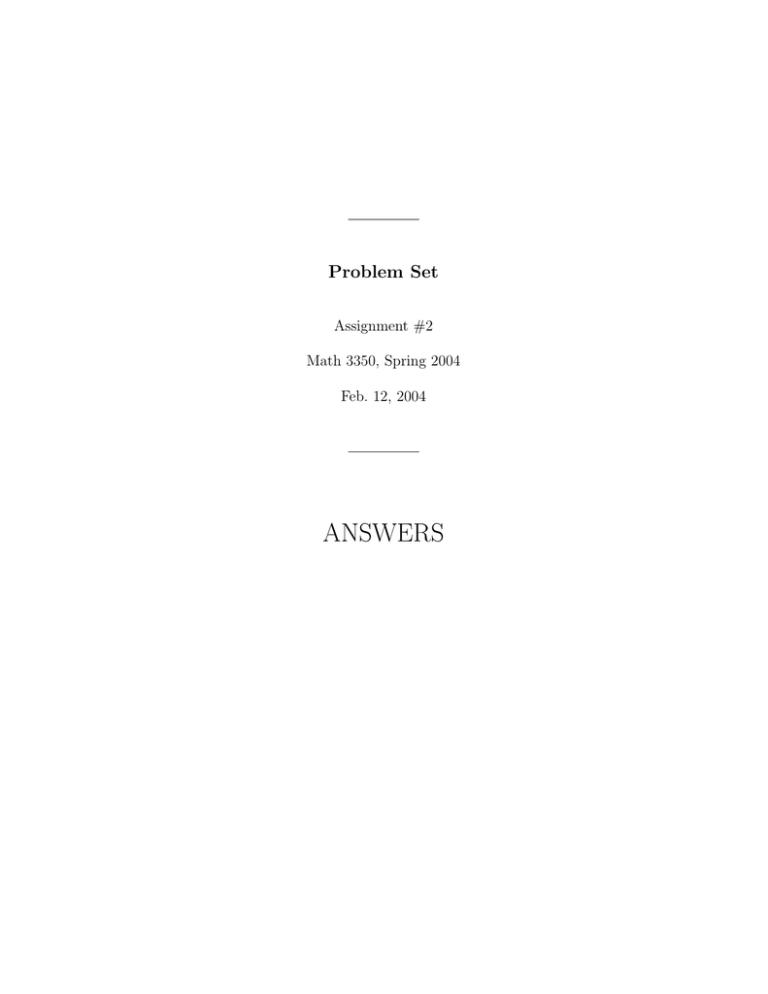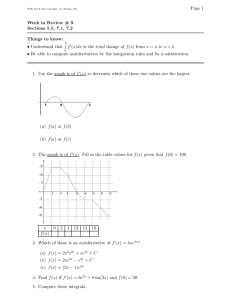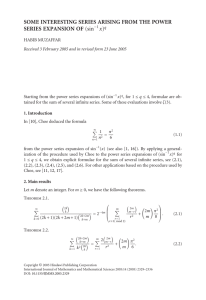ANSWERS Problem Set Assignment #2 Math 3350, Spring 2004
advertisement

Problem Set Assignment #2 Math 3350, Spring 2004 Feb. 12, 2004 ANSWERS i Problem 1. [Section 1.6, Problem 16] Solve the following initial value problem. (1.1) y 0 − (1 + 3/x)y = x + 2, y(1) = e − 1. Answer : This is a first order linear equation. Comparing with the standard form y 0 + p(x)y = r(x), we see that p(x) = −(1 + 3/x). In general, the integrating factor is Z F = exp p(x) dx . In this case, we have Z Z p(x) dx = − (1 + 3/x) dx = −x − 3 ln|x| = −x − ln|x3 |, and so 3 3 F = e−x−ln|x | = e−x e− ln|x | = e−x e−x ∼ , |x3 | x3 dropping the absolute value signs as usual. Multiplying (1.1) through by F , we get the equation −x e e−x e−x 2e−x e−x dy + − − 3 y= 2 + 3 . 3 3 4 x dx x x x x which is the same as d e−x e−x 2e−x y = + , dx x3 x2 x3 (check it). From this we get (1.2) e−x y= x3 Z e−x 2e−x + 3 2 x x dx The integral is a little tricky. Call it R. We have, of course, Z −x Z e 2e−x (1.3) R= dx + dx. 2 x x3 Neither of these integrals is elementary. However, let’s apply integration by parts to the first integral Z −x e dx. x2 In the integration by parts formula Z Z 0 uv dx = uv − u0 v dx, 1 let u = x−2 and v 0 = e−x . Then u0 = −2x−3 and v = −e−x . Thus, we have Z Z Z −x e−x 2 e−x 2e−x e −x dx = − − − (−e ) dx = − − dx. x2 x2 x3 x2 x3 Plugging this back into (1.3), we get Z Z e−x 2e−x 2e−x e−x dx. + dx = − +C R=− 2 − x x3 x3 x2 (!). Of course, once you know the answer, it’s easy to check it by differentiation. Going back to (1.2), we have e−x e−x y = − + C. x3 x2 Solving for y gives us y = −x + Cx3 ex (1.4) as the general solution of (1.1). To apply the initial condition y(1) = e − 1, set x = 1 in (1.4). This yields the equation e − 1 = y(1) = −1 + Ce. The solution is C = 1. Putting this value of C into the general solution, we get y = −x + x3 ex as the solution of the initial value problem (1.1). Problem 2. [Section 1.6, Problem 38] Reduce to linear form and solve the following equation (2.1) 2xyy 0 + (x − 1)y 2 = x2 ex , (y 2 = z). Answer : Using the hint, introduce a new dependent variable z by z = y 2 . Then z 0 = 2yy 0 . Substituting in the equation (2.1), we get the equation x dz + (x − 1)z = x2 ex . dx To put this equation in standard form, divide both sides by x. This yields (2.2) dz + (1 − 1/x)z = xex . dx 2 This is a first order linear equation for z. The integrating factor is Z F = exp (1 − 1/x) dx = exp(x − ln|x|) = ex e− ln|x| ex = |x| ex ∼ . x Multiplying both sides of (2.2) by F gives the equation d ex z = e2x . dx x Integrating both sides of this equation gives ex 1 z = e2x + C. x 2 Solving this for z gives z= 1 x xe + Cxe−x . 2 y2 = 1 x xe + Cxe−x 2 Recalling that z = y 2 , we get as an implicit general solution of (2.1). Problem 3. [Section 2.1, Problem 6] Reduce to first order and solve (3.1) xy 00 + 2y 0 + xy = 0, y1 = sin(x)/x. Answer : We want to use the method of reduction of order. To save time, we’ll use the book’s formula (9) on page 70 (the blue box), which reads (3.2) U= 1 − R p dx e . y12 The derivation of this formula assumes the equation is in the standard form (3.3) y 00 + p(x)y 0 + q(x)y = 0. 3 To put our equation (3.1) into the standard form (3.3), we divide both sides of (3.1) by x to get 2 y 00 + y + y = 0. x Comparing this with (3.3), we have p(x) = 2/x. Thus, Z Z 2 p(x) dx = dx = 2 ln|x| = ln(x2 ). x Plugging into (3.2), we have 1 − R p dx e y12 2 1 e− ln(x ) = sin2 (x) x2 1 1 = 2 sin (x) x2 x2 1 = 2 sin (x) U= = csc2 (x). Following page 70 of the book, we have Z u = U dx Z = csc2 (x) dx = − cot(x), Thus, the second solution to the differential equation is y2 = uy1 sin(x) x cos(x) sin(x) =− sin(x) x cos(x) =− . x = − cot(x) Now that we have to linearly independent solutions of (3.1), we can write down the general solution as y = c1 y1 + c2 y2 = c1 4 sin(x) cos(x) − c2 . x x Since c2 is an arbitrary constant, we can absorb the minus sign into c2 and write the equivalent formula sin(x) cos(x) y = c1 + c2 x x Problem 4. [Section 2.1, Problem 12] Reduce to first order and solve (4.1) (1 − x2 )y 00 − 2xyy 0 + 2y = 0, y1 = x. Answer : We use the same formulas from the book as in the previous problem. To put the equation (4.1) into standard form, we divide through by 1 − x2 . This gives us the equation 2 2x 0 y + y = 0. y 00 − 2 1−x 1 − x2 Thus, we have p(x) = −2x/(1 − x2) and Z Z 2x p(x) dx = − dx = ln|1 − x2 |, 1 − x2 (by simple substitution). Using the book’s formula (9) on page 70, we have U= = = ∼ = 1 − R p dx e y12 1 − ln|1−x2 | e x2 1 1 x2 |1 − x2 | 1 1 x2 1 − x2 1 , x2 (1 − x2 ) dropping the absolute value signs as usual. Next, we have to compute Z Z 1 u = U dx = dx. 2 x (1 − x2 ) If this was Calc II, we would do this integral by partial fractions. We’ll get into partial fractions later, but right now let’s just ask our calculator to evaluate this integral. The result is u= 1 1 1 ln|x + 1| − ln|x − 1| − . 2 2 x 5 We then have y2 = uy1 = 1 1 x ln|x + 1| − x ln|x − 1| − 1. 2 2 If you’re nervous, you can check this is a solution by differentiating and plugging into the equation. Now that we have y1 and y2 , we can write down the general solution of (4.1) as 1 1 y = c1 x + c2 x ln|x + 1| − x ln|x − 1| − 1 . 2 2 6







